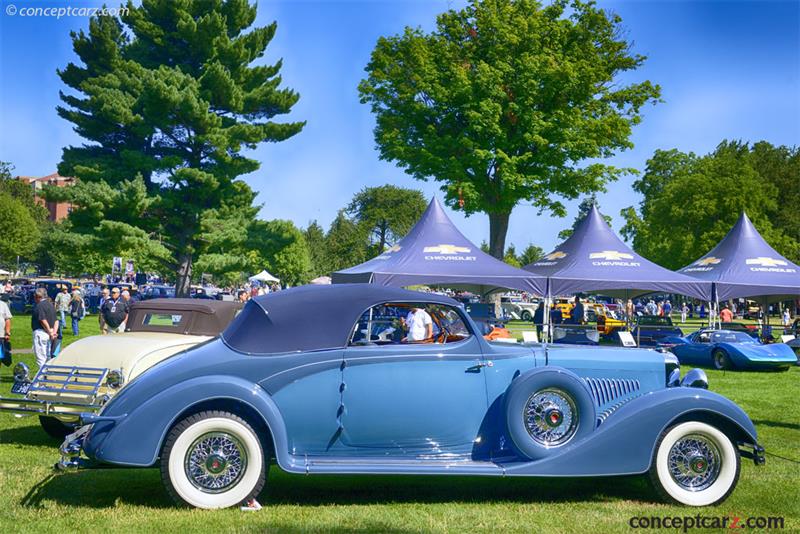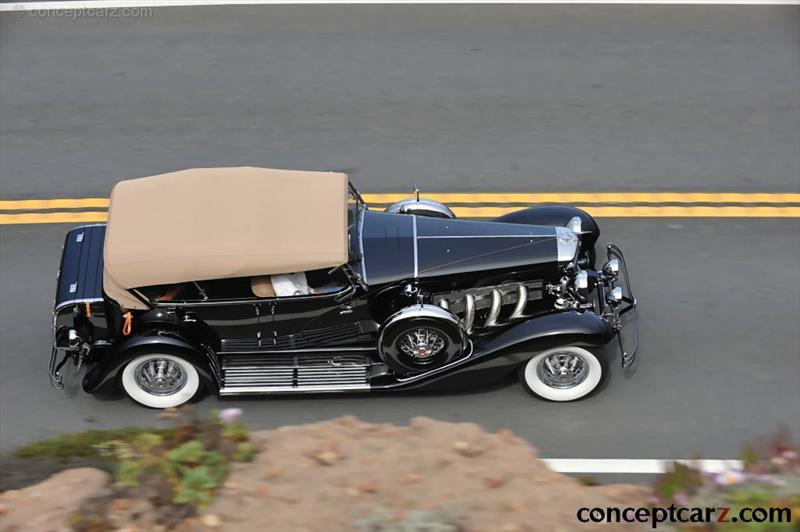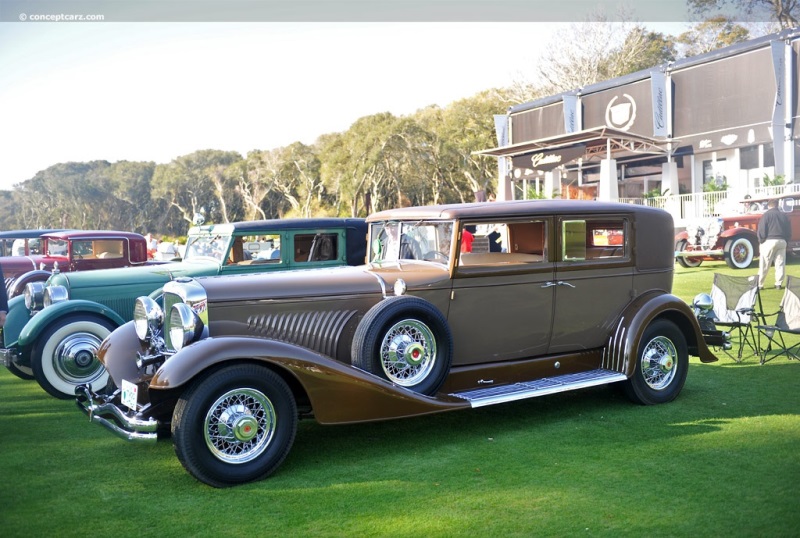Many of the Duesenberg Model J's specifications remain current in modern times, a testament to the highly skilled engineering and ingenuity endowed upon the model. Indeed, its 265 horsepower, four valves per cylinder, double overhead camshafts, and eventually, an optional supercharger meets or exceeds the specifications for many modern vehicles. Upon its introduction, trading was halted on the New York Stock exchange for the announcement. The bare chassis was listed for a staggering $8,500 making it by far the most expensive car in America and among the most expensive in the world. Several fully clothed Duesenbergs had price tags that reached or exceeded $20,000, a staggering sum considering that a typical new family car costs around $500.
The Duesenberg Model J was introduced on December 1st of 1928 at the Auto Salon opening in New York. It was the star of the show and Duesenberg ordered enough components to build 500 Model Js while development continued for six months after the Model J's introduction. The first customer delivery came in May 1929, barely five months before Black Tuesday. The Great Depression decimated the industry and unfortunately, the Model J lacked financing and support from E.L. Cord and Auburn Corporation, and ultimately, 481 examples would be built including 36 Model SJ. Duesenberg Motors Company went bankrupt in 1937.
Fred and August Duesenberg were self-taught mechanics and car builders whose careers started in the Midwest at the beginning of the twentieth century with the manufacture of cars bearing the Mason and Maytag names. Fred was five years older than August and he was the designer and tinkerer of the pair. Augie's talents lay in making Fred's ideas come to life.
The Duesenberg brother's designs and creativity inspired many early American automobile manufacturers, and over half a dozen marques used their four-cylinder engine produced by Rochester. Many of the stars of the era who drove their racing cars include Harry Hartz, Roscoe Sarles, Rex Mays, Peter DePaolo, Tommy Milton, Albert Guyot, Ralph DePalma, Eddie Rickenbacker, Fred Frame, Deacon Litz, Joe Russo, Stubby Stubblefield, Jimmy Murphy, Joe Boyer, L.L. Corum, George Souders, Jimmy Gleason, Ralph Mulford, and Ab Jenkins.
A total of 70 Duesenberg vehicles would compete through 15 consecutive Indianapolis 500s, beginning with their first appearance in 1913. 46 percent of those (a total of 32) would finish in the top 10.
The Duesenberg brothers became renowned for their vehicle's reliability and expertise with superchargers. The engines were on par with the best of the era, including those from Miller, Peugeot, and Ballot.
In 1921, Jimmy Murphy brought a Duesenberg to the French Grand Prix at Le Mans, making it the first car with hydraulic brakes to start a Grand Prix. The Duesenberg won the event and backed up this spectacular performance at Indianapolis in 1922 when eight of the top ten cars were Duesenberg-powered. Murphy's winning car utilized a Duesenberg chassis and Miller engine and was called the 'Murphy Special.'
When Errett Lobban Cord decided to create an automobile that would surpass the great marques of America and Europe, he turned to the Duesenberg Motors Company, adding them to his rapidly-growing enterprise, the Auburn Automobile Company, on October 26, 1926. The new company was renamed 'Duesenberg, Inc.' and Fred Duesenberg was tasked with building the greatest car in the world. The result of this monumental endeavor was the Duesenberg Model J. Initially, August contributed nothing to the initial design of the J nor was associated with Duesenberg, Inc. until later. All of the Duesenberg racing cars produced after 1926, however, were built by Augie in a building apart from the primary Duesenberg plant. He did help design the superchargers used by both Auburn and Cord motorcars.
The Duesenberg Model J rested on a 142.5-inch wheelbase chassis, nearly 12 feet. A longer 153.5-inch platform was also available. Two SSJ models rested on a shortened 125-inch platform and a few examples had platforms that exceeded 160 inches. The 420 cubic-inch straight eight-cylinder engine had double overhead camshafts, four valves per cylinder, and delivered 265 horsepower. It had a 3.74-inch cylinder bore and a piston stroke of 4.76 inches. The block and head material were formed from cast iron and it used a 5.7:1 compression ratio. The carburetor was a single updraft Schleber unit. Each chassis was driven at speed for 100 miles at the Indianapolis Motor Speedway, ensuring reliability and durability. Most of the chassis and engines were built in 1929 and 1930 and were sold throughout subsequent years as the Great Depression crippled demand. Thus, the year assigned to specific Duesenberg vehicles refers to the vehicle's completion date or the date it was purchased, rather than the year the chassis and engine were built.
The Model J vehicles received a live axle suspension with semi-elliptical leaf springs and double-acting hydraulic-lever shock absorbers. Stopping power was provided by four-wheel hydraulic drum brakes.
Several modifications were introduced throughout the Model J's production lifespan, the earliest of which was the replacement of the four-speed gearbox with an unsynchronised three-speed gearbox which was better suited to handle the engine's power.
The interior featured mechanically timed lights that would remind the driver when to perform routine maintenance, such as inspecting the battery and changing the oil.
Approximately half of the Model Js wore coachwork designed by the company's chief body designer, Gordon Buehrig, and built under the name La Grande by company branches in Denver, Florida, Los Angeles, Philadelphia, Chicago, and New York City. The list of American-based independent coachbuilders who clothed the Model J includes Le Barin, Murphy (who built approximately 140 bodies for the J), Rollston (later renamed Rollson), Derham, Holbrook, Judkins, Walker, Weymann, and Willoughby. Among the European coachbuilders include Jean-Baptiste Franay, Saoutchik, Gurney Nutting, Letourneur and Marchand, Figoni, Graber, Van den Plas, and Fernandez et Darrin.
The Duesenberg Model J had approximately twice as much horsepower as any other motorcar of the era, outclassing all others in ease of handling, riding quality, comfort, luxury, longevity, and smoothness. Quite simply, the Duesenberg excelled, in every way, against every other automobile in the world. Vanity Fair announced in May 1930 that Duesenberg was the winner of Elegance Rallyes at Cannes and Pau France, in competition with 150 of the period's world's costliest cars.
Not confined to the U.S., the Duesenbergs were made available throughout the world. Duesenbergs Export Manager, Vance C. Hall introduced the J to Europe, making its European debut in Paris at the 23rd Annual Salon d' Automobile held at the Grand Palais in October 1929. The J was later shown at the London Show, and then at motorcar exhibits in Prague, Geneva, and Milan.
The Duesenberg Model J remains among the true icons of the Classic Era and one of the most desirable of all American automobiles.
by Daniel Vaughan | Dec 2021
The Duesenberg Model J was introduced on December 1st of 1928 at the Auto Salon opening in New York. It was the star of the show and Duesenberg ordered enough components to build 500 Model Js while development continued for six months after the Model J's introduction. The first customer delivery came in May 1929, barely five months before Black Tuesday. The Great Depression decimated the industry and unfortunately, the Model J lacked financing and support from E.L. Cord and Auburn Corporation, and ultimately, 481 examples would be built including 36 Model SJ. Duesenberg Motors Company went bankrupt in 1937.
Fred and August Duesenberg were self-taught mechanics and car builders whose careers started in the Midwest at the beginning of the twentieth century with the manufacture of cars bearing the Mason and Maytag names. Fred was five years older than August and he was the designer and tinkerer of the pair. Augie's talents lay in making Fred's ideas come to life.
The Duesenberg brother's designs and creativity inspired many early American automobile manufacturers, and over half a dozen marques used their four-cylinder engine produced by Rochester. Many of the stars of the era who drove their racing cars include Harry Hartz, Roscoe Sarles, Rex Mays, Peter DePaolo, Tommy Milton, Albert Guyot, Ralph DePalma, Eddie Rickenbacker, Fred Frame, Deacon Litz, Joe Russo, Stubby Stubblefield, Jimmy Murphy, Joe Boyer, L.L. Corum, George Souders, Jimmy Gleason, Ralph Mulford, and Ab Jenkins.
A total of 70 Duesenberg vehicles would compete through 15 consecutive Indianapolis 500s, beginning with their first appearance in 1913. 46 percent of those (a total of 32) would finish in the top 10.
The Duesenberg brothers became renowned for their vehicle's reliability and expertise with superchargers. The engines were on par with the best of the era, including those from Miller, Peugeot, and Ballot.
In 1921, Jimmy Murphy brought a Duesenberg to the French Grand Prix at Le Mans, making it the first car with hydraulic brakes to start a Grand Prix. The Duesenberg won the event and backed up this spectacular performance at Indianapolis in 1922 when eight of the top ten cars were Duesenberg-powered. Murphy's winning car utilized a Duesenberg chassis and Miller engine and was called the 'Murphy Special.'
When Errett Lobban Cord decided to create an automobile that would surpass the great marques of America and Europe, he turned to the Duesenberg Motors Company, adding them to his rapidly-growing enterprise, the Auburn Automobile Company, on October 26, 1926. The new company was renamed 'Duesenberg, Inc.' and Fred Duesenberg was tasked with building the greatest car in the world. The result of this monumental endeavor was the Duesenberg Model J. Initially, August contributed nothing to the initial design of the J nor was associated with Duesenberg, Inc. until later. All of the Duesenberg racing cars produced after 1926, however, were built by Augie in a building apart from the primary Duesenberg plant. He did help design the superchargers used by both Auburn and Cord motorcars.
The Duesenberg Model J rested on a 142.5-inch wheelbase chassis, nearly 12 feet. A longer 153.5-inch platform was also available. Two SSJ models rested on a shortened 125-inch platform and a few examples had platforms that exceeded 160 inches. The 420 cubic-inch straight eight-cylinder engine had double overhead camshafts, four valves per cylinder, and delivered 265 horsepower. It had a 3.74-inch cylinder bore and a piston stroke of 4.76 inches. The block and head material were formed from cast iron and it used a 5.7:1 compression ratio. The carburetor was a single updraft Schleber unit. Each chassis was driven at speed for 100 miles at the Indianapolis Motor Speedway, ensuring reliability and durability. Most of the chassis and engines were built in 1929 and 1930 and were sold throughout subsequent years as the Great Depression crippled demand. Thus, the year assigned to specific Duesenberg vehicles refers to the vehicle's completion date or the date it was purchased, rather than the year the chassis and engine were built.
The Model J vehicles received a live axle suspension with semi-elliptical leaf springs and double-acting hydraulic-lever shock absorbers. Stopping power was provided by four-wheel hydraulic drum brakes.
Several modifications were introduced throughout the Model J's production lifespan, the earliest of which was the replacement of the four-speed gearbox with an unsynchronised three-speed gearbox which was better suited to handle the engine's power.
The interior featured mechanically timed lights that would remind the driver when to perform routine maintenance, such as inspecting the battery and changing the oil.
Approximately half of the Model Js wore coachwork designed by the company's chief body designer, Gordon Buehrig, and built under the name La Grande by company branches in Denver, Florida, Los Angeles, Philadelphia, Chicago, and New York City. The list of American-based independent coachbuilders who clothed the Model J includes Le Barin, Murphy (who built approximately 140 bodies for the J), Rollston (later renamed Rollson), Derham, Holbrook, Judkins, Walker, Weymann, and Willoughby. Among the European coachbuilders include Jean-Baptiste Franay, Saoutchik, Gurney Nutting, Letourneur and Marchand, Figoni, Graber, Van den Plas, and Fernandez et Darrin.
The Duesenberg Model J had approximately twice as much horsepower as any other motorcar of the era, outclassing all others in ease of handling, riding quality, comfort, luxury, longevity, and smoothness. Quite simply, the Duesenberg excelled, in every way, against every other automobile in the world. Vanity Fair announced in May 1930 that Duesenberg was the winner of Elegance Rallyes at Cannes and Pau France, in competition with 150 of the period's world's costliest cars.
Not confined to the U.S., the Duesenbergs were made available throughout the world. Duesenbergs Export Manager, Vance C. Hall introduced the J to Europe, making its European debut in Paris at the 23rd Annual Salon d' Automobile held at the Grand Palais in October 1929. The J was later shown at the London Show, and then at motorcar exhibits in Prague, Geneva, and Milan.
The Duesenberg Model J remains among the true icons of the Classic Era and one of the most desirable of all American automobiles.
by Daniel Vaughan | Dec 2021
Background
The Duesenberg Company produced high-end, luxury automobiles and racing cars from 1913 through 1937. It was created by the Duesenberg brothers, Fred and August, who formed the Duesenberg Automobile %26 Motors Company, Inc. in Des Moines, Iowa with the intent on building sports cars. Just like many of their time, they were mostly self-taught engineers and had only constructed experimental cars up to....
Continue Reading >>
Continue Reading >>
Related Reading : Duesenberg Model J History
The Duesenberg Automobile %26 Motors Company, Inc was founded and operated by Fred and August, brothers who began their company in 1913. From the start, the company has been a US-based luxury automobile company with a standard to build the very best hand-built vehicles during the time period. Duesenberg vehicles lived up to this standard until 1937 when the company closed. Created to build sports....
Continue Reading >>
Continue Reading >>
1935 Duesenberg Model J Vehicle Profiles
Sweep Panel Dual-Cowl Phaeton
Coachwork: LaGrande
Designer: Gordon Buehrig
Chassis #: 2558
Engine #: J-537
Recent Vehicle Additions
Performance and Specification Comparison
Model J Specification Comparison by Year
Year
Production
Wheelbase
Engine
Prices
125.00 in., 142.50 in.
8 cyl., 420.00 CID., 265.00hp
8 cyl., 420.00 CID., 320.00hp
8 cyl., 420.00 CID., 320.00hp
$8,500 - $8,500
Related Automotive News

Past Best of Show Winners at The Pebble Beach Concours d'Elegance
overview1
The 70th anniversary of the Pebble Beach Concours dElegance was celebrated with a spectacular display of previous Best of Show winners. Thirty-seven examples graced the showfield and many were still with the same owners who raised the trophy...

Alfa Romeo Named Best of Show at the 68th Pebble Beach Concours d'Elegance
Touring-Bodied Alfa Romeo 8C 2900B Named Best of Show at the 68th Pebble Beach Concours dElegance
PEBBLE BEACH, Calif. (August 26, 2018) — After an intense competition that drew diverse cars from around the globe, the coveted gold Best of Show...

1929 Mercedes-Benz S Barker Tourer Named Best Of Show At The 67Th Pebble Beach Concours d'Elegance
PEBBLE BEACH, Calif. (August 20, 2017) — Just a week ago, Bruce R. McCaws 1929 Mercedes-Benz S Barker Tourer emerged from the restoration shop of Steve Babinsky in Lebanon, New Jersey. Today, having crossed the country, the boattailed beauty captured...

120 years of motor sport at Mercedes-Benz take centre stage at the Goodwood Festival of Speed 2014
Addicted to Winning at this years Goodwood Festival of Speed, Mercedes-Benz looks back on some fascinating racing victories of the last 120 years
The unique motor sport heritage of the Mercedes-Benz brand is being celebrated with an exclusive i...

Techno Classica 2014: more than 30 racing cars to celebrate 120 years of Mercedes-Benz motor racing history
Cars that were the heroes of magical moments put their stamp on this high-powered, most comprehensive show presentation
With more than 30 vehicles, Mercedes-Benz Classic presents motor racing history in all its unique breadth and depth
120 years o...


































